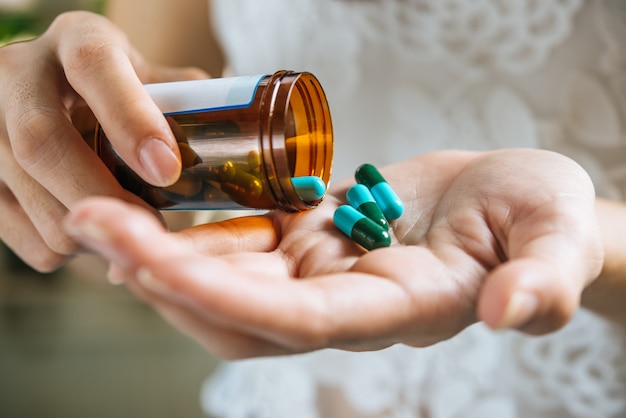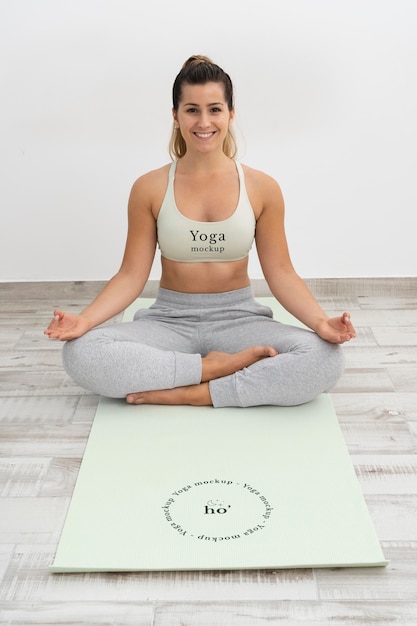How to Get Rid of Period Cramps: 7 Effective Relief Strategies


Scientifically recognised as dysmenorrhea, menstrual cramps are a distressing monthly occurrence for many women. These discomforting sensations in the lower abdomen frequently interfere with routine tasks and activities.
Dr Alyssa Dweck, a renowned New York-based gynaecologist, reiterates that both primary (not caused by an underlying disease) and secondary (caused by an identifiable medical problem such as endometriosis) dysmenorrhea do not have to cause severe agony each time menstrual period ensues.
All individuals with ovaries undergo the natural cyclic process known as the menstrual cycle, which generally has four phases: Menstruation phase, when bleeding occurs; Follicular or proliferative phase, wherein lining repair happens; Ovulation, where eggs are released due to hormonal signals; Luteal or secretory stage signalling body'sbody's preparation for pregnancy - evident through thickening uterine lining walls meant for embryo implantation if fertilisation took place.
Experiencing symptoms like fatigue, bloating or mood swings might be typical across cycles, while other manifestations, including debilitating cramping and spell trouble, warrant consultation with health experts.

The menstrual cycle symbolises the recurring hormonal alterations in the female anatomy, gearing up for possible conception. These modifications typically induce ovulation—a process by which mature eggs are discharged from the ovaries—and changes in the thickness of the uterine lining to accommodate the potential nesting of a fertilised egg.
Regular cycles typically last around 28 days, but variations between 21 and 35 days are also considered normal depending on one's age and physiological condition. Statistics reveal menstruation usually starts at puberty - between ages 12–15 years, with perimenopause (the transition phase leading into menopause) happening often during the late forties or early fifties.
The entire process is divided into four main stages:
Associate Professor Dr Sarah Jarvis emphasises understanding individual patterns plays a crucial role in managing reproductive health, enabling awareness over abnormal discrepancies warranting professional consultation such as persistent heavy bleeding/ missed periods /unusual spotting indicating underlying medical issues including, among other things, Polycystic Ovary Syndrome, cervical cancer, amongst others reinforcing significance maintaining vigilance concerning any alteration personal patterns ensuring proactive, ongoing management women related healthcare concerns.

Menstrual cycle symptoms vary significantly among individuals, with a notable fluctuation even within the same person's consecutive cycles. From mild to severe, these signs encompass both physical and emotional changes:
Monitoring these symptoms aids individuals in comprehending personal patterns, discerning abnormalities thereof, and achieving better reproductive health management.
Period cramps, known as dysmenorrhea in medical terminology, constitute a common problem for many women who experience painful periods. There exist several effective strategies to alleviate such discomfort:

Heat application is an integral part of effective strategies for menstrual cramp relief. When a warm compress or heating pad is applied to the lower abdomen, it operates as a self-care approach that aims to soothe discomfort and ease pain.
From the physiology perspective, applying heat facilitates dilation (widening) of blood vessels in the uterus, which is medically referred to as vasodilation. Enhanced vasodilation promotes an increase in oxygen uptake and nutrient supply to uterine muscles while accelerating the removal of waste products, including those responsible for eliciting painful sensations during periods such as Isoprostanes.
Simultaneously, warmth aids the relaxation of muscular tension, often manifesting added aches during the monthly cycle, thereby contributing to an overall decrease in discomfort experienced.
Dr Jill Rabin, Co-Chief of Division Ambulatory Care Women's Health Programs-PCAP Services Northwell Health, underlines the importance of maintaining appropriate safety precautions while employing methods reminding users never to apply direct, intense sources to avoid skin burns. Instead, it recommends commercially available thermostatic-controlled devices designed specifically to ensure preset temperature limit adherence to relieve without inflicting harm.

Massage therapy serves as a highly effective strategy to provide relief from the discomfort of menstrual cramps. This non-invasive, drug-free approach primarily focuses on manipulating soft body tissues using different degrees and types of pressure coupled with movement.
A professional therapist often employs various techniques designed specifically for pain mitigation, such as Swedish or deep tissue massage– concentrating targeted efforts around the lower abdomen area where cramping typically occurs during the menstruation phase every cycle.
The science behind how a therapeutic massage yields benefits involves its potential to enhance blood circulation within massaged areas. Cramping results from uterine muscle contractions, which restrict blood flow; through executing regulated rhythmic strokes encompassing kneading/tapping movements along strategic points of the abdominal wall, improved oxygenation, among other nutrients, reaches affected muscles, facilitating relaxation, thus offering respite against persistent spasms perceived intensely by sufferers.
Moreover, massages assist in stimulating endorphin production–the body's natural painkillers inducing ''feel good'' sensations while counteracting stress hormone elevations known as exacerbating period pains, thereby complimentarily allaying associated emotional upheavals, rendering holistic wellness solutions aptly suitable across varied users keen exploring alternative remedies alleviating dysmenorrhea induced agony proactively each time menses sets course recurrently month after month.

Regular exercise is a potent strategy to alleviate menstrual cramps. Essentially, being active releases endorphins - natural painkillers that interact with brain receptors, altering the perception of discomfort and offering relief from period pains.
Aerobic activities like swimming, walking, or cycling enhance blood circulation, easing muscle tension in the abdominal area, which often mitigates period-induced pain. Strength-training exercises targeting core muscles provide:
Yoga also proves effective against menstrual distress. Specific poses, such as a child's pose, stretch the pelvic region, and mindful breathing techniques induce a calming effect. Thus, they lessen the severity of bloating and cramps commonly encountered across cycles. Likewise, they foster overall strength and flexibility, combatting fatigue effectively.
High-intensity interval Training (HIIT) work-outs considerably boost mood/energy levels, aiding in alleviating dysmenorrhea. Pilates, which focuses on encouraging core strength/stability, has been shown to positively abate associated symptoms.
However, always ensure you do not overdo these routines, especially during acute painful phases, adjust according to personal comfort, stay hydrated, promote optimum muscle functionality, and prevent dehydration-cause cramping. Rest adequately post work-out facilitating recovery, reinforcing adherence to strategic consistent approach, achieving maximum benefit, and making each monthly cycle more bearable than previously perceived.
Dietary modifications are a potent strategy for easing menstrual discomfort, primarily by regulating hormones, reducing inflammation and ensuring optimal physiological functioning. Here are some specific adjustments one might consider:
Minimise Processed food and sugar-salted items. An inclusion diet counters unnecessary water retention, manages premenstrual weight gain issues, and improves overall well-being. It is always advisable to consult with a nutritionist or healthcare specialist before making substantial dietary changes to ensure balanced nutritional assimilation without compromising any other health aspect, keeping long-term wellness goals in sight.

Over-the-counter (OTC) drugs have been shown to provide significant alleviation from menstrual cramps or dysmenorrhea. These medications fall primarily into two groups: Non-Steroidal Anti-Inflammatory Drugs (NSAIDs) and Acetaminophen.
NSAIDs: Ibuprofen, Naproxen, and Aspirin are examples of such medicines that work on mitigating the creation of chemicals in the body known as prostaglandins, which trigger pain. Prostaglandins serve as hormones contributing to inflammatory responses and causing contractions in uterine muscles during menstruation, thus resulting in discomfort or painful sensations.
Acetaminophen: Another popular OTC medicine, Tylenol, is an effective alternative to NSAIDs, providing substantial period cramp alleviation albeit via a different mechanism—it acts centrally on the brain, dampening pain perception rather than slowing down prostaglandin synthesis like its counterpart.
Despite their easy accessibility without requiring a doctor's prescription, it's imperative to note that every medication carries potential side effects. For instance, prolonged use might lead to stomach ulcers/liver damage with reference to NSAIDs & Acetaminophen, respectively.
Furthermore, individuals having asthma/bleeding disorders/pre-existing liver disease require exercising caution while considering such therapeutic intervention. Hence, despite being non-prescriptive, class, science-backed evidence firmly advocates seeking healthcare professional advice before initiating any self-medication course, thereby assuring safety alongside desired efficacy.
Thus, if menstrual agony seems unmanageable, relying solely on lifestyle amendments indicated above, there certainly exists pharmaceutical recourse enhancing life quality drastically, making periods less intimidating phenomena indeed.
You can read more on medications for menstrual cramps here. To view our full range of pain relief medication, see our Pain Relief Treatment page here.

Contraceptive pills, also known as oral contraceptives or birth control pills, offer a dual advantage of not only preventing unplanned pregnancies but relieving menstrual cramps as well.
Oral contraceptive options contain synthetic forms of hormones oestrogen and/or progesterone - working by regulating hormone levels throughout the cycle. As such, hormonal fluctuations responsible for preparing the uterus lining to thicken and anticipate pregnancy are controlled considerably, reducing uterine muscle activity during menstruation and causing lesser intense contractions.
Moreover, these medications play a pivotal role in inhibiting the overproduction of prostaglandins - substances triggering painful uterine muscular contractions leading to period discomfort; thus, it becomes altogether less severe among pill users compared to non-users.
However, providing a holistic picture of potential side effects like nausea, breast tenderness, headaches, and mood swings might accompany their use. Importantly, some even carry serious health implications, viz., blood clots/heart attacks/strokes, underlining the imperative nature of an individualised approach ensuring suitability safety prior to prescription besides regular monitoring by health professionals mitigating associated risks judiciously and enabling optimal symptomatic relief from menstrual agony optimally.

Alternative therapies such as acupuncture and yoga offer promising relief from menstrual cramps. Acupuncture, a traditional Chinese therapy technique, stimulates certain points in the body to restore energy flow or ''chi,'' which aids pain management. A study published by NIH affirms its effectiveness against dysmenorrhea.
With its physical postures and breathing exercises, yoga promotes relaxation, thus alleviating abdominal tension during menstruation. Research endorses yoga for easing period-related discomfort.
Before embracing any new therapeutic approach, though, it is essential to consult with healthcare providers first to ensure suitability, align personal health requirements, circumvent undesirable outcomes, and bolster optimal benefit realisation through an informed choice foundation.
It's pertinent to remember that what eases one person's symptoms might not yield the same effect on another—hence, it becomes an individual journey to discover what best suits personal needs, paving the way towards a less daunting monthly menses occurrence.
To reduce period cramps fast, apply heat on the lower abdomen or consider over-the-counter pain relievers such as Non-steroidal Anti-Inflammatory Drugs (NSAIDs), always under guidance from a healthcare provider.
Herbal teas like chamomile and ginger, known for their anti-inflammatory properties, have shown potential in stopping menstrual discomfort when consumed warm, assisting muscle relaxation and easing spasms.
Foods rich in essential nutrients, notably Magnesium, Calcium, Vitamin E, and omega-3 fatty acids, help alleviate inflammation/pain severity during menses, aiding effective symptomatic management complementarity.
Foods high in sodium/sugar /trans fats /caffeine are advisable; being avoided for periods can exacerbate bloating/cramps/mood swings through water retention, stimulating diuresis intermittently.
Warm liquids are generally recommended for comforting drinks during menstruation; herbal infusions, decaf green tea, and water with lemon are prime choices for soothingly hydrating concurrently.
Bananas make excellent fruit choices during periods due to their potassium content, which helps fight bloated feelings and enhances mood through the presence of tryptophan, which is converted into serotonin, the brain's happy chemical.
Understanding and managing menstrual health effectively invites an amalgamation of strategies, from lifestyle adjustments to medical intervention. Embracing a holistic approach encapsulating balanced nutrition and regular physical activity alongside stress management techniques like yoga helps optimise overall well-being, ensuring reduced intensity of painful periods. Simultaneously, critical remains open dialogue with healthcare providers, enabling proactive individual care plans based on informed decisions and promoting effective ailment control confidently, thereby holistically fostering optimal reproductive health outcomes.










Plus get the inside scoop on our latest content and updates in our monthly newsletter.